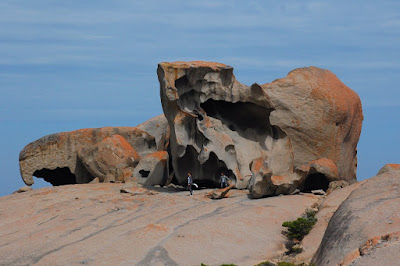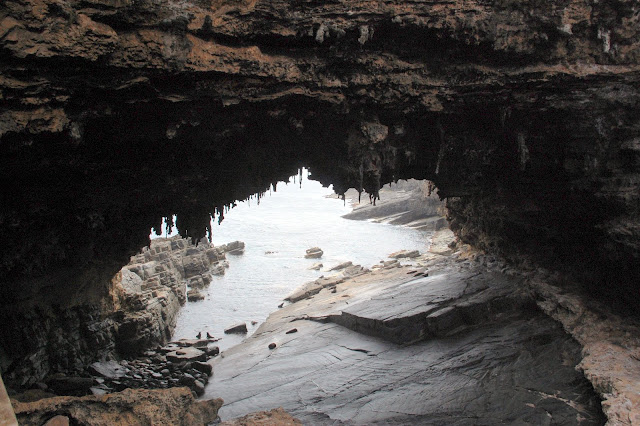Exploring Southwest
Itinerary: Kelly Hill Caves - Koala Walk in Hanson Bay Sanctuary - Flinders Chase National Park (Remarkable Rocks, Admiral Arch, Weirs Cove, Cape du Coedic)

We started the day by visiting Kelly Hill Caves at Kelly Hill Conservation Park. There is a folk tale of an unfortunate horse named Kelly that fell into one of many cave's sink holes in 1880. Kelsy, who rode Kelly, managed to climb out, but the horse stayed at the bottom.
The only way to explore these caves is with a guided tour. What we saw - a maze of 5-6 caves full of halls, passages, impressive stalagmites, stalactites, and straws - is only 0.1% of the discovered area of 105 cave systems. Cave-explorers can spend 2-3 days at a stretch in the underground world that stretches 9km.
As a family adventure, this 30-45min tour was great! The caves were dim to give a feel of the cave world, the ranger was knowledgeable and entertaining, and the length was sufficient to keep the kids interested. There is a 2-hour caving tour for the more adventurous who would like to crawl and slide through narrow dark passages.
Koala are very common in KI, literally falling off the trees. But the most remarkable koala encounter we had was at Koala Walk in Hanson Bay Sanctuary. Sitting low on a branch, there was an incredibly alert, fluffy, bear-like tiny joey, who couldn't take his eyes off of us - he was so interested! His sleepy mom sat close.
This little area lined with gum trees is home to many kangaroos, tammar wallabies, possums, echidnas and koalas, of course. We saw a number of bright-colored birds that I call parrots, but in truth were lorikeets, crimson rosellas, black cockatoos, etc.
When the koala population on the mainland was threatened with extinction, in the 1920s, 20-23 koalas were introduced to Kangaroo Island. They were so happy there, numbers grew in no time to 30,000 and they were chomping their way through the gum trees, their only food source, at an alarming rate. To control the population as well as save KI's delicate ecosystem, a sterilisation plan was introduced by the South Australian Government that is still in place.
The next stop was Flinders Chase National Park that boasts of the most remarkable attractions in KI. Before venturing any further we had al fresco lunch at the park's Chase Cafe. While the Nomads busied themselves in the kids' archeological dig, the Big Nomad and I made a quick walk along the Discovery Trail.
Remarkable Rocks at Kirpatrick Point was our next destination - these beautiful wind-sculpted rock formations sit atop a smooth granite dome. Slippery southern slopes are only 75m above the ocean and there were a few accidents when people were washed off the rocks at high tides and strong waves. Taking precautions and holding the Nomads' little hands were a much bigger concern than the beauty of the rocks.
We made our way further west, along the most southern road on KI, which runs along the edge of the cliff to Cape du Coedic. The road opens sights of spectacular steep cliffs and emerald waters of the bay. En route we stopped at Weirs Cove to see remnants of a store room and a flying fox structure, that brought supplies up the cliffs for the lighthouse's family starting in early 1900s. The steamer came here once in 3 month.
At Cape du Coedic we started a 5-km hike through low-growing bush. We soon reached the 1906 lighthouse perched atop wild and remote point. This brutal coastline, underwater reef cutters, two islands (the Casuarinas) extending some 35-40 km boast 14 shipwrecks!
A boardwalk leads down to yet another couple of landmarks: the rugged cliffs and natural rock pools are a favorite spot of New Zealand fur seals. We descended to Admiral Arch - a spectacular arch-way formed by pounding seas and strong winds. The seals here are only 30m away - frisky, playful, and so smelly!
This isolated point with seal-covered rocks, harsh winds, damp air, acrid smell of animals felt so wild and so remote! I couldn't help but wonder how any human could make his living there, let alone a family with children!
We climbed back to the top of the cliff and made our way back through the rest of the trail.
We were back at the cottage by 6pm to catch the evening sun and waves at the beach. After another rustic dinner we sat by the fire pit and once the night fell, we ventured into complete darkness of KI with flashlights, hoping to see nocturnal wildlife action. The Little Nomads' loud voices didn't entice any wild animals to come out and after this self-guided nocturnal walk and a long day, the kids were fast asleep.
Itinerary: Kelly Hill Caves - Koala Walk in Hanson Bay Sanctuary - Flinders Chase National Park (Remarkable Rocks, Admiral Arch, Weirs Cove, Cape du Coedic)

We started the day by visiting Kelly Hill Caves at Kelly Hill Conservation Park. There is a folk tale of an unfortunate horse named Kelly that fell into one of many cave's sink holes in 1880. Kelsy, who rode Kelly, managed to climb out, but the horse stayed at the bottom.
The only way to explore these caves is with a guided tour. What we saw - a maze of 5-6 caves full of halls, passages, impressive stalagmites, stalactites, and straws - is only 0.1% of the discovered area of 105 cave systems. Cave-explorers can spend 2-3 days at a stretch in the underground world that stretches 9km.
As a family adventure, this 30-45min tour was great! The caves were dim to give a feel of the cave world, the ranger was knowledgeable and entertaining, and the length was sufficient to keep the kids interested. There is a 2-hour caving tour for the more adventurous who would like to crawl and slide through narrow dark passages.
 |
| Koala Joey at Koala Walk |
This little area lined with gum trees is home to many kangaroos, tammar wallabies, possums, echidnas and koalas, of course. We saw a number of bright-colored birds that I call parrots, but in truth were lorikeets, crimson rosellas, black cockatoos, etc.
When the koala population on the mainland was threatened with extinction, in the 1920s, 20-23 koalas were introduced to Kangaroo Island. They were so happy there, numbers grew in no time to 30,000 and they were chomping their way through the gum trees, their only food source, at an alarming rate. To control the population as well as save KI's delicate ecosystem, a sterilisation plan was introduced by the South Australian Government that is still in place.
The next stop was Flinders Chase National Park that boasts of the most remarkable attractions in KI. Before venturing any further we had al fresco lunch at the park's Chase Cafe. While the Nomads busied themselves in the kids' archeological dig, the Big Nomad and I made a quick walk along the Discovery Trail.
 |
| Remarkable Rocks |
We made our way further west, along the most southern road on KI, which runs along the edge of the cliff to Cape du Coedic. The road opens sights of spectacular steep cliffs and emerald waters of the bay. En route we stopped at Weirs Cove to see remnants of a store room and a flying fox structure, that brought supplies up the cliffs for the lighthouse's family starting in early 1900s. The steamer came here once in 3 month.
 |
| Cape du Coedic with Casuarinas islets and Admiral Arch opening |
A boardwalk leads down to yet another couple of landmarks: the rugged cliffs and natural rock pools are a favorite spot of New Zealand fur seals. We descended to Admiral Arch - a spectacular arch-way formed by pounding seas and strong winds. The seals here are only 30m away - frisky, playful, and so smelly!
This isolated point with seal-covered rocks, harsh winds, damp air, acrid smell of animals felt so wild and so remote! I couldn't help but wonder how any human could make his living there, let alone a family with children!
We climbed back to the top of the cliff and made our way back through the rest of the trail.
 |
| New Zealand fur seals at Cape du Coedic |
 |
| Admiral Arch |
We were back at the cottage by 6pm to catch the evening sun and waves at the beach. After another rustic dinner we sat by the fire pit and once the night fell, we ventured into complete darkness of KI with flashlights, hoping to see nocturnal wildlife action. The Little Nomads' loud voices didn't entice any wild animals to come out and after this self-guided nocturnal walk and a long day, the kids were fast asleep.
No comments:
Post a Comment